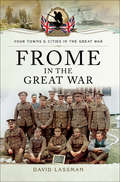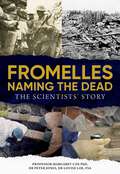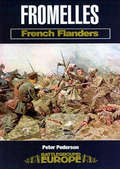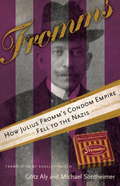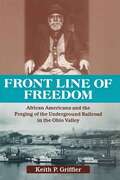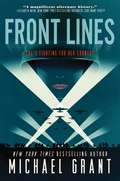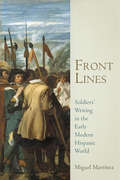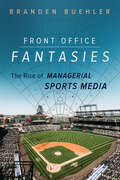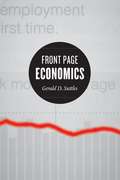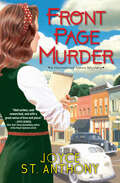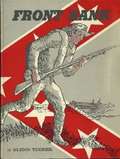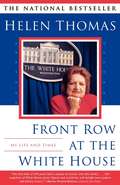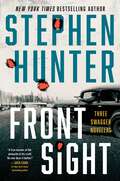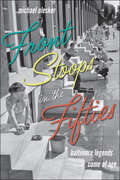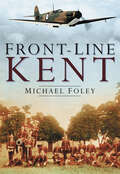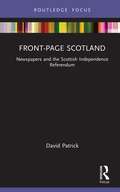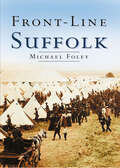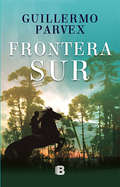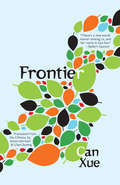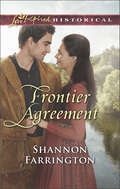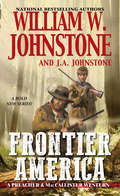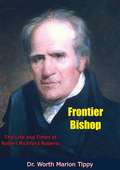- Table View
- List View
Frome in the Great War (Your Towns & Cities in the Great War)
by David LassmanThe Somerset town of Frome is something of a paradox. Since being founded at the end of the sixth century its fiercely independent nature has been unchanging. A nature which, as one columnist has noted: 'seems to have revolved around the eminently sensible attitude of To hell with national events! We will stay as we are.' And yet a century ago, when called on by its country to do its duty in the Great War, it rose to the task admirably. Men from Frome and the surrounding area experienced action in all the theatres of war that the global conflict encompassed, and they took part in the numerous battles and campaigns, on land and at sea, that have become synonymous with that conflict: Ypres, Gallipoli, Jutland, the Somme. At the same time, its civilian population received a special commendation after the war for its effort throughout it. However, the towns contribution did not stop there, as many of the returning soldiers helped to create several of the national and international monuments and memorials that would pay eternal tribute to their comrades who fell on the fields of Flanders and elsewhere. Using letters, diaries, photographs, newspaper reports and eyewitness accounts, along with other archive material, local historian and author David Lassman has assembled the story of Frome during the Great War; a story which charts the transformation of this once rich and powerful textile centre and manufacturing town, along with its people, through the life-changing events of 1914 to 1918
Fromelles – Naming the Dead: The Scientists' Story
by Professor Margaret Cox Dr Peter Jones PhD Dr Louise LoeThis is the extraordinary story of the engagement between 250 young Australians, who enlisted in 1915 and died in the Battle of Fromelles of 1916, their families, and three British scientists. In 2009, the bodies of these 250 soldiers were excavated by Oxford Archaeology. Among them were the Wilson brothers who, with their comrades were subsequently reburied in individual marked graves in the new cemetery in Fromelles village. The Battle of Fromelles needs no introduction, nor do the losses sustained. Here we focus on 166 of the 250 soldiers who were excavated from six mass graves adjacent to Pheasant Wood in 2009 and who have since been identified. Each has his own story to tell as does his family. We explore aspects of these lost lives while telling the story of their recovery and identification. This is the story of how these lost soldiers were excavated and identified. It is told by the scientists who led the excavation, the anthropological and DNA analyses, and the identification process. It is their story of involvement with and commitment to this fascinating project, in which many combined decades of professional experience were pooled to help achieve a fitting final resting place, names restored, for these brave men, and belated solace for their families. Much has been written about the Battle of Fromelles, the missing soldiers, their families&’ quests to restore their identities and the discovery and excavation of the graves. This book tells a new story. it is the scientist&’s story behind naming the Fromelles&’ dead.
Fromelles: French Flanders (Battleground Europe)
by Peter PedersenHistorian Peter Pedersen examines the World War I battle on the Western Front that decimated an Australian regiment in Fromelles: French Flanders.The attack at Fromelles is significant for a number of reasons. It was the Australians’ first major operation on the Western Front and pitted them against a part of the German line that was an object lesson in the siting of a defense. Before the battle, the Australian Gallipoli veterans had airily dismissed the fighting in the new theater as “pleasant”. After it, they said grimly that Anzac was “a picnic” compared to France. Fromelles came as a terrible shock and was a foretaste of things to come. Both the genesis and aftermath of the operation were controversial. The objectives and the tactics employed to achieve them were changed several times and the sufficiency of resources vigorously debated. After the war, the British and Australian Official Historians argued as to how the battle should be interpreted. Most of the correspondence that accompanied their exchange of drafts has not been published. Peter Pedersen’s thorough account of the battle explores the genesis of the operation through the aftermath covering this monumental moment in World War I history.
Fromms
by Shelley Frisch Michael Sontheimer Gotz AlyIf you wanted to buy a top-quality condom in prewar Germany, you bought Fromms Act, the first brand name condom and still a leading brand in the German market. The man behind this "pure German quality product" was Julius Fromm, a Jewish entrepreneur who had immigrated from Russia as a child. Fromm was in the right place at the right time: he patented Fromms Act in 1916, when the combination of changing sexual mores, awareness of sexual health, and the lack of reliable prophylactics meant a market primed for his product. In 1922 he began mass production and opened international branches. Sixteen years later, after building the brand into a best seller and the company into a model business, he was forced to sell Fromms Act for a fraction of its worth to a German baroness. In 1939 he emigrated to London.Aly and Sontheimer trace Fromm's rise and fall, illuminating the ways Jewish businesses like his were Aryanized under the Nazis. Through the biography of this businessman and the story of his unusual and fabulously successful company, we learn the fascinating history of the first branded condoms in Germany and the sexual culture that allowed them to thrive, the heretofore undocumented machinations by which the Nazis robbed German-Jewish families of their businesses, and the tragedy of a man whose great love for the adopted country that first allowed him to succeed was betrayed by its government and his fellow citizens. This captivating account offers a wealth of detail and a fresh array of photographic documentation, and adds a striking new dimension to our understanding of this dark period in German history.From the Hardcover edition.
Fromms: How Julius Fromm's Condom Empire Fell to the Nazis
by Götz Aly Michael SontheimerIf you wanted to buy a top-quality condom in prewar Germany, you bought Fromms Act, the first brand name condom and still a leading brand in the German market. The man behind this “pure German quality product” was Julius Fromm, a Jewish entrepreneur who had immigrated from Russia as a child. Fromm was in the right place at the right time: he patented Fromms Act in 1916, when the combination of changing sexual mores, awareness of sexual health, and the lack of reliable prophylactics meant a market primed for his product. In 1922 he began mass production and opened international branches. Sixteen years later, after building the brand into a best seller and the company into a model business, he was forced to sell Fromms Act for a fraction of its worth to a German baroness. In 1939 he emigrated to London. Aly and Sontheimer trace Fromm’s rise and fall, illuminating the ways Jewish businesses like his were Aryanized under the Nazis. The authors also recount the Fromm family’s quest for reparations, one that came to an end only in 2006. Through the biography of this businessman and the story of his unusual and fabulously successful company, we learn the fascinating history of the first branded condoms in Germany and the sexual culture that allowed them to thrive, the heretofore undocumented machinations by which the Nazis robbed German-Jewish families of their businesses, and the tragedy of a man whose great love for the adopted country that first allowed him to succeed was betrayed by its government and his fellow citizens. This captivating account offers a wealth of detail and a fresh array of photographic documentation, and adds a striking new dimension to our understanding of this dark period in German history.
Front Line Of Freedom: African Americans And The Forging Of The Underground Railroad In The Ohio Valley (Ohio River Valley Ser.)
by Keith P. GrifflerThe Underground Railroad, an often misunderstood antebellum institution, has been viewed as a simple combination of mainly white "conductors" and black "passengers." Keith P. Griffler takes a new, battlefield-level view of the war against American slavery as he reevaluates one of its front lines: the Ohio River, the longest commercial dividing line between slavery and freedom. In shifting the focus from the much discussed white-led "stations" to the primarily black-led frontline struggle along the Ohio, Griffler reveals for the first time the crucial importance of the freedom movement in the river's port cities and towns. Front Line of Freedom fully examines America's first successful interracial freedom movement, which proved to be as much a struggle to transform the states north of the Ohio as those to its south. In a climate of racial proscription, mob violence, and white hostility, the efforts of Ohio Valley African Americans to establish and maintain communities became inextricably linked to the steady stream of fugitives crossing the region. As Griffler traces the efforts of African Americans to free themselves, Griffler provides a window into the process by which this clandestine network took shape and grew into a powerful force in antebellum America.
Front Lines
by Michael GrantPerfect for fans of The Book Thief and Code Name Verity, New York Times bestselling author Michael Grant unleashes an epic, genre-bending, and transformative new series that reimagines World War II with girl soldiers fighting on the front lines.World War II, 1942. A court decision makes women subject to the draft and eligible for service. The unproven American army is going up against the greatest fighting force ever assembled, the armed forces of Nazi Germany.Three girls sign up to fight. Rio Richlin, Frangie Marr, and Rainy Schulterman are average girls, girls with dreams and aspirations, at the start of their lives, at the start of their loves. Each has her own reasons for volunteering: Rio fights to honor her sister; Frangie needs money for her family; Rainy wants to kill Germans. For the first time they leave behind their homes and families--to go to war.These three daring young women will play their parts in the war to defeat evil and save the human race. As the fate of the world hangs in the balance, they will discover the roles that define them on the front lines. They will fight the greatest war the world has ever known.
Front Lines: Soldiers' Writing in the Early Modern Hispanic World
by Miguel MartínezIn Front Lines, Miguel Martínez documents the literary practices of imperial Spain's common soldiers. Against all odds, these Spanish soldiers produced, distributed, and consumed a remarkably innovative set of works on war that have been almost completely neglected in literary and historical scholarship. The soldiers of Italian garrisons and North African presidios, on colonial American frontiers and in the traveling military camps of northern Europe read and wrote epic poems, chronicles, ballads, pamphlets, and autobiographies--the stories of the very same wars in which they participated as rank-and-file fighters and witnesses. The vast network of agents and spaces articulated around the military institutions of an ever-expanding and struggling Spanish empire facilitated the global circulation of these textual materials, creating a soldierly republic of letters that bridged the Old and the many New Worlds of the sixteenth and seventeenth centuries.Martínez asserts that these writing soldiers played a key role in the shaping of Renaissance literary culture, which for its part gave to them the language and forms with which to question received notions of the social logic of warfare, the ethics of violence, and the legitimacy of imperial aggression. Soldierly writing often voiced criticism of established hierarchies and exploitative working conditions, forging solidarities among the troops that often led to mutiny and massive desertion. It is the perspective of these soldiers that grounds Front Lines, a cultural history of Spain's imperial wars as told by the common men who fought them.
Front Office Fantasies: The Rise of Managerial Sports Media (Studies in Sports Media)
by Branden BuehlerFront office executives have become high-profile commentators, movie and video game protagonists, and role models for a generation raised in the data-driven, financialized world of contemporary sports. Branden Buehler examines the media transformation of these once obscure management figures into esteemed experts and sporting idols. Moving from Moneyball and Football Manager to coverage of analytics gurus like Daryl Morey, Buehler shows how a fixation on managerial moves has taken hold across the entire sports media landscape. Buehler’s chapter-by-chapter look at specific media forms illustrates different facets of the managerial craze while analyzing the related effects on what fans see, hear, and play. Throughout, Buehler explores the unsettling implications of exalting the management class and its logics, in the process arguing that sports media’s managerial lionization serves as one of the clearest reflections of major material and ideological changes taking place across culture and society. Insightful and timely, Front Office Fantasies reveals how sports media moved the action from the field to the executive suite.
Front Page Economics
by Gerald D. Suttles Mark D. JacobsIn an age when pundits constantly decry overt political bias in the media, we have naturally become skeptical of the news. But the bluntness of such critiques masks the highly sophisticated ways in which the media frame important stories. In Front Page Economics, Gerald Suttles delves deep into the archives to examine coverage of two major economic crashes—in 1929 and 1987—in order to systematically break down the way newspapers normalize crises. Poring over the articles generated by the crashes—as well as the people in them, the writers who wrote them, and the cartoons that ran alongside them—Suttles uncovers dramatic changes between the ways the first and second crashes were reported. In the intervening half-century, an entire new economic language had arisen and the practice of business journalism had been completely altered. Both of these transformations, Suttles demonstrates, allowed journalists to describe the 1987 crash in a vocabulary that was normal and familiar to readers, rendering it routine. A subtle and probing look at how ideologies are packaged and transmitted to the casual newspaper reader, Front Page Economics brims with important insights that shed light on our own economically tumultuous times.
Front Page Murder (A Homefront News Mystery)
by Joyce St. AnthonyIn this World War II-era historical mystery series debut by Joyce St. Anthony, small-town editor Irene Ingram has a nose for news and an eye for clues.Irene Ingram has written for her father&’s newspaper, the Progress Herald, ever since she could grasp a pencil. Now she&’s editor in chief, which doesn&’t sit well with the men in the newsroom. But proving her journalistic bona fides is the least of Irene&’s worries when crime reporter Moe Bauer, on the heels of a hot tip, turns up dead at the foot of his cellar stairs. An accident? That&’s what Police Chief Walt Turner thinks, and Irene is inclined to agree until she finds the note Moe discreetly left on her desk. He was on to a big story, he wrote. The robbery she&’d assigned him to cover at Markowicz Hardware turned out to be something far more devious. A Jewish store owner in a small, provincial town, Sam Markowicz received a terrifying message from a stranger. Moe suspected that Sam is being threatened not only for who he is…but for what he knows. Tenacious Irene senses there&’s more to the Markowicz story, which she is all but certain led to Moe&’s murder. When she&’s not filling up column inches with the usual small-town fare—locals in uniform, victory gardens, and scrap drives—she and her best friend, scrappy secretary Peggy Reardon, search for clues. If they can find the killer, it&’ll be a scoop to stop the presses. But if they can&’t, Irene and Peggy may face an all-too-literal deadline.
Front Rank [Illustrated Edition]
by Glenn TuckerIncludes more than 20 illustrationsFamed Civil War historian Glen Tucker was commissioned by the North Carolina Confederate Centennial Commission to write a short portrait of the men and battles that the soldiers from North Carolina fought under the Stars and Bars. Illustrated beautifully throughout by Bill Ballard, the author takes the reader on to the battlefields of the Civil War and through his vivid vignettes records the immortal deeds of the North Carolinians from Manassas to the last shot at Appomattox.
Front Row at the White House: My Life and Times
by Helen Thomas"I'm still here, still arriving at the White House in the wee hours of the morning, reading the papers and checking the wire, still waiting for the morning briefing, still sitting down to write the first story of the day and still waiting to ask the tough questions." From the woman who has reported on every president from Kennedy to Clinton for United Press International: a unique glimpse into the White House -- and a telling record of the ever-changing relationship between the presidency and the press. From her earliest years, Helen Thomas wanted to be a reporter. Raised in Depression-era Detroit, she worked her way to Washington after college and, unlike other women reporters who gave up their jobs to returning veterans, parlayed her copy-aide job at the Washington Daily News into a twelve-year stint as a radio news writer for UPI, covering such beats as the Department of Justice and other federal agencies. Assigned to the White House press corps in 1961, Thomas was the first woman to close a press conference with "Thank you, Mr. President," and has covered every administration since Kennedy's. Along the way, she was among the pioneers who broke down barriers against women in the national media, becoming the first female president of the White House Correspondents Association, the first female officer of the National Press Club and the first woman member, later president, of the Gridiron Club. In this revealing memoir, which includes hundreds of anecdotes, insights, observations, and personal details, Thomas looks back at a career spent with presidents at home and abroad, on the ground and in the air. She evaluates the enormous changes that Watergate brought, including diminished press access to the Oval Office, and how they have affected every president since Nixon. Providing a unique view of the past four decades of presidential history, Front Row at the White House offers a seasoned study of the relationship between the chief executive officer and the press -- a relationship that is sometimes uneasy, sometimes playful, yet always integral to democracy. "Soon enough there will be another president, another first lady, another press secretary and a whole new administration to discover. I'm looking forward to it -- although I'm sure whoever ends up in the Oval Office in a new century may not be so thrilled about the prospect."
Front Sight: Three Swagger Novellas (Earl Swagger)
by Stephen HunterA collection of three interconnected novellas that follow each generation of the iconic Swagger family—grandfather Charles, father Earl, and fan favorite hero Bob Lee—from New York Times bestselling author, Pulitzer Prize winner, and &“true master at the pinnacle of his craft&” (Jack Carr, #1 New York Times bestselling author) Stephen Hunter.In City of Meat, Charles Swagger is on the hunt for notorious bank robber Baby Face Nelson when he traces a tip to the Chicago stock yards. While there, he&’s brutally assaulted by a madman involved in a nearby narcotics ring. The ring plans to spread its new drug to the residents of the disenfranchised 7th District of Chicago and to make matters worse, this is no ordinary drug—it makes some users happy, drives others insane, and kills many of the rest. Will Charles be able to stop the ring before it&’s too late? Or is he in over his head among the dark streets of Chicago? Earl Swagger investigates a violent bank robbery that left two dead and a fortune missing in small-town Maryland in Johnny Tuesday. At every turn, however, he&’s met with silence and hostility from the townsfolk, which makes sense when he uncovers municipal corruption, gang politics, jaded aristocrats, scheming gamblers, a hitman, a femme fatale, and a whole bunch of men with guns. Luckily, Earl has brought his own guns in this unputdownable noir mystery. Finally, in Five Dolls for the Gut Hook, a thirty-two-year-old Bob Lee Swagger is back from Vietnam nearly broken over good men lost for nothing. He&’s turned down that whiskey road to hell. But one afternoon he&’s awakened from his nightmares by two men with a problem. As nearby Hot Springs tries to retool its image from gambling paradise to family resort, a butcher has begun to prey on the city&’s young women, a figure straight out of a horror movie. Hot Springs Homicide is baffled and recruit Bob&’s help. &“I&’m a sniper,&” says Bob, &“not a detective.&” &“But,&” comes the reply, &“you are the son and grandson of two of the greatest detectives this state has ever produced.&” On that premise alone, Bob takes up the hunt for a killer who not only kills but desecrates. At the same time, we understand that Bob Lee Swagger is also hunting for his own salvation.
Front Stage: முன் மேடை
by A. Ramasamyநாடகக் கதையைத் தொடங்குவதற்கு முன்பு பார்வையாளர்களை ஒருவிதக் களிப்பு மனநிலையில் நிலைகொள்ளச் செய்து அன்றையமேடை நிகழ்விற்கு தயார்ப்படுத்தும் பணிகளைத் தெருகூத்தின் கட்டியங்காரனும், ஸ்பெஷல் நாடகத்தின் பபூனும் செய்வான். கூத்திலும் சரி, ஸ்பெஷல் நாடகத்திலும் சரி, இந்த அம்சம் தவிர்க்க முடியாத அம்சங்களாகப் பார்வையாளர்கள் கருதினார்கள். ஸ்பெஷல் நாடகங்களில் பபூன் -காமிக் நடைபெறும் வரை கூட்டம் அலைமோதும். கதையின் மையப் பாத்திரங்கள் வரும்போது கூட்டம் குறையும் பின்னர் முக்கியமான தர்க்கங்களின் போது தூங்கியவர்கள் விழித்துக் கொள்வார்கள்.
Front Stoops in the Fifties: Baltimore Legends Come of Age
by Michael OleskerFamous Baltimoreans growing up in the fifties.Front Stoops in the Fifties recounts the stories of some of Baltimore's most famous personalities as they grew up during the "decade of conformity." Such familiar names as Jerry Leiber, Nancy Pelosi, Thurgood Marshall, and Barry Levinson figure prominently in Michael Olesker’s gripping account, which draws on personal interviews and journalistic digging.Olesker marks the end of the fifties with the assassination of President John F. Kennedy. "It’s as if millions will suddenly decide to act out their anxieties and their rage, as if Kennedy’s murder exposed some hypocrisy at the heart of the American dream," he writes. Focusing on the period leading up to this turning point in U.S. history, Olesker looks to the individuals living through the changes that were just beginning to surface and would later come to prominence in the sixties.The fifties are often remembered with longing as a more innocent time. But it was also a suffocating time for many. Alongside innocence was ignorance. Olesker tells the story of Nancy D’Alesandro Pelosi, daughter of the mayor, who grew up in a political home and eventually became the first woman Speaker of the House. Thurgood Marshall, schooled in a racially segregated classroom, went on to argue Brown v. Board of Education of Topeka before the U.S. Supreme Court and rewrite race-relations law. Even the music changed. Olesker’s doo-wop portrait of Baltimore is nostalgic, but it has a hard edge.
Front Stoops in the Fifties: Baltimore Legends Come of Age
by Michael OleskerThis personal history of prominent Baltimoreans sheds light on the social transformations already taking place in the supposedly innocent 1950s. Front Stoops in the Fifties recounts the stories of some of Baltimore&’s most famous personalities as they grew up during the &“decade of conformity&”—just before they entered the turbulent 1960s. Focusing on the period before JFK&’s assassination, Olesker looks to individuals who would go on to influence the brewing cultural revolution. Such familiar names as Jerry Leiber, Nancy Pelosi, Thurgood Marshall, and Barry Levinson figure prominently in Michael Olesker&’s fascinating account, which draws on personal interviews and journalistic research. Olesker tells the story of Nancy D&’Alesandro Pelosi, daughter of the mayor, who grew up in a political home and eventually became the first woman Speaker of the House. Thurgood Marshall, schooled in a racially segregated classroom, went on to argue Brown v. Board of Education of Topeka before the U.S. Supreme Court and rewrite race-relations law. These and many other stories come to life in Front Stoops in the Fifties. &“[A] fascinating read . . . The shocking part is just how relevant these stories remain today.&” —Baltimore Post-Examiner &“[A] crisp, insightful dispatch from a skilled writer who knows his city and its history.&” —David Simon, executive producer of HBO&’s The Wire
Front-Line Kent
by Michael FoleyKent has been on England's first line of defence. In all major conflicts many people in the county have lived closer to the enemy in Europe than they did to London. Much of the county's coastline has been the site of training and weapon development, which adds to the interest of military sites in this area. Michael Foley's new book delves into the long history of military Kent, from Roman forts to Martello towers, built to keep Napoleon out, from the ambitious Royal Military Canal, which cost an equivalent of GBP10 million in today's money but was abandoned after seventy years, to wartime airfields and underground Cold War installations. Illustrated with a wide range of photographs, maps, drawings, engravings and paintings, Front-Line Kent also includes location and access details for the sites that are illustrated and described. This lively and informative book will appeal to anyone interested in Kent's history, whether or not a military specialist.
Front-Page Scotland: Newspapers and the Scottish Independence Referendum (Routledge Focus on Journalism Studies)
by David PatrickThis book provides a varied, thorough and informative analysis of how newspapers covered the 2014 Scottish independence referendum in its critical final months. Providing a wealth of new empirical findings, the book engages with the key themes and issues which emerge from within the discourses themselves. Among the main observations are: the marginalisation of women, both as subjects and producers of the news; the late emergence of the London-based media to take the vote entirely seriously; the often myopic focus on Alex Salmond; and the framing of the debate through contrasting narratives of positive democratic engagement and societal division within Scotland. The book will be the first point of contact for readers interested in the subject, providing an overview which is meticulously researched, authoritative and engaging, and offering broader insights in the areas of journalism, political communication and media studies.
Front-line Suffolk
by Michael FoleySuffolk's coastline faces east, and through most of its history has therefore been one of the areas of this country that has been at risk from invasion during times of conflict. This title delves into history of military Suffolk, from Saxon shore forts to castles or castle sites, Napoleonic martello towers and Second World War airfields.
Frontera sur
by Guillermo ParvexLa historia del Wallmapu contada a través de Pedro Borquez, un chileno que rompe sus prejuicios y se va a vivir con los mapuche. Novela histórica ambientada en el siglo XIX (1835-1859) en Chile; la historia se enmarca en una época en que la naciente república de Chile y la nación mapuche mantenían una relación entre estados, a veces no exenta de roces, pero que en general se caracterizó por una sana y pacífica convivencia, con territorios y atribuciones claramente delimitados, en que fluían en forma normal las actividades comerciales y las relaciones políticas y militares.
Frontier
by Chen Zeping Karen Gernant Can Xue Porochista KhakpourThough the story of Liujin, a young woman seeking a new kind of human freedom, Frontier attempts to unify the grand opposites of life--barbarism and civilization, the spiritual and the material, the mundane and the sublime, beauty and death, Eastern and Western cultures. A layered, multifaceted masterpiece from the 2015 winner of the Best Translated Book Award.
Frontier Agreement
by Shannon FarringtonFORCED TO WED When half-Native American translator Claire Manette joins her mother's tribe after her father's death, she's told she must marry or leave the village. Lewis and Clark expedition member Pierre Lafayette's offer of a marriage of convenience is enticing. But with her refusal to leave her family behind and his dreams of exploring uncharted territories, it would never work. Pierre joined the expedition for adventure...and to avoid settling down. So why does he feel compelled to protect a stranger by marrying her? The only thing he's sure of is that he can't allow Claire to be forced from the only home she has left. Pierre and Claire are an unlikely match, but amid the wilderness of the West, could his offer of duty become one of love?
Frontier America (A Preacher & MacCallister Western #1)
by William W. Johnstone J.A. JohnstonePREACHER + MacCALLISTER = DOUBLE THE MAYHEM Two of the Johnstones’ most legendary heroes—the rugged mountain man known as Preacher and the Scottish clan rancher Jamie Ian MacCallister, here together for the first time—are forced to choose sides in a blood-soaked battle for the heart and soul of a nation divided . . . FRONTIER AMERICA As the father of a young Crow tribesman, Preacher would like nothing more than to see the long-time natives and newly arrived settlers live together in peace. Then the killing starts . . . As a family man and frontiersman, Jamie Ian MacCallister is more than happy to help the officers at Fort Kearny negotiate a peace treaty with the Crow nation. Until it all goes to hell . . . This is not the American dream they were looking for. This is a nightmare. A brutal, blood-drenched frontier war that two heroic men must fight and win—or one struggling nation will never come together. For liberty and justice for all . . . Live Free. Read Hard.
Frontier Bishop: The Life and Times of Robert Richford Roberts
by Dr Worth Marion TippyThis book, written by Dr. Worth Marion Tippy in 1958, is a biography of Robert Richford Roberts (1778-1843), an American Methodist Circuit Rider, Pastor, Presiding Elder, and the first married man in America to serve as Bishop of the Methodist Episcopal Church, elected in 1816.Born in Frederick County, Maryland, his family were communicants of The Church of England. In 1785, they moved to the Ligonier Valley in Westmoreland County, Pennsylvania, where Roberts united with the M.E. Church when he was fourteen years old. Until he was twenty-one, his was a thoroughly frontier existence, with few books and quite simple habits. Despite becoming one of the “foremost religious leaders of his time,” he remained a frontiersman to the day of his death in 1843.“Long after he became a bishop he liked to follow deer in the forest. When he was free, being now a bishop, to live where he chose, he established his episcopal residence in what was then wilderness of the hill country of southern Indiana. Here, in utmost seclusion, he lived for the next quarter century, at first under most primitive conditions. From this isolated place he left on horseback on his amazing episcopal journeys to all parts of the nation, returning after long absences to work on his lands.”Dr. Tippy tells of Bishop Roberts’ move from his native Maryland to the then-frontier of western Pennsylvania, where his father had secured four hundred acres of land in the Ligonier Valley fifty miles east of Pittsburgh, and where the young Roberts would go on to experience the hardships and adventures of migrants before and after him—experiences which “better prepared for the leadership which came to him so early in life.”An invaluable read.
